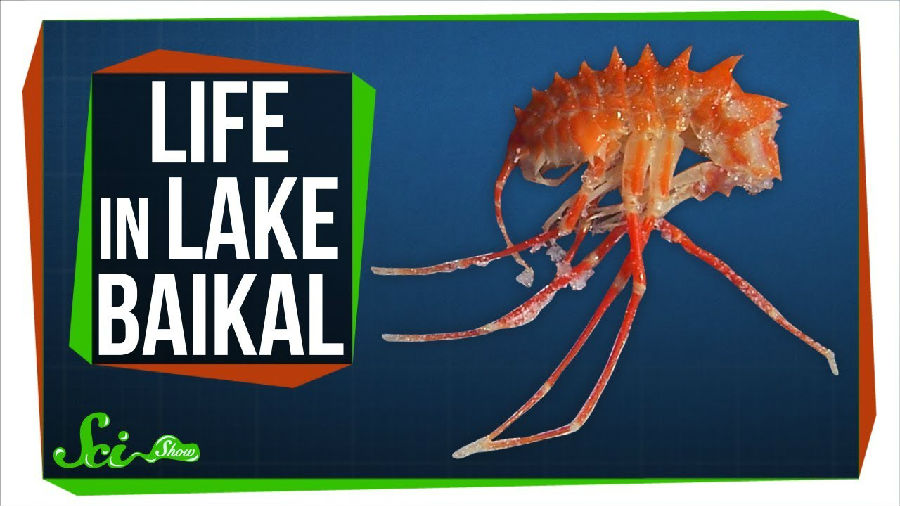At over 1600 meters deep and some 25 million years old, Lake Baikal in Russia is the world's deepest and oldest lake.
俄罗斯贝加尔湖深约1600多米,拥有约2500万年历史的贝加尔湖是世界上最深最悠久的湖泊。
And you know what that means: Since time immemorial, we've been curious about what lies at the bottom of it.
这意味着:自远古以来,我们一直都很好奇这个深邃的湖底到底有些什么。
According to the Buryat, the indigenous people of Siberia, the lake is home to a giant fishy dragon monster called Lusud-Khan.
据西伯利亚原住民布里亚特人所说,湖底住着像鱼一样的巨大的恐龙怪物—Lusud-Khan。
Sort of like the Loch Ness Monster of Russia. Others say the water hides sunken train cars full of a Russian admiral's gold.
有点像是俄罗斯的尼斯湖水怪。其他人说水底藏着沉没的火车,里边满是俄罗斯海军上将的黄金。
And some claim to have seen aliens or mysterious lights in its depths.
一些人说在湖底看见过外星人或是神秘灯光。
Of course, those stories have yet to be proven, but the true story of Lake Baikal might be almost as strange.
当然,那些故事还有待证实,但是贝加尔湖真实的故事或许也是一样的怪异。
The lake is what's known as a rift valley.
这条湖是一个裂谷。
It formed as two tectonic structures (the Siberian platform and the Amurian/North China plate) moved away from each other.
两个大地构造(西伯利亚地台和阿穆尔/华北板块)相互分离而形成了裂谷。
And its geography is still evolving today.
如今其地形还在进化。
As many as 2000 mini-earthquakes (or tremors) occur at the lake every year, and it gets about 2 cm wider annually.
这里每年要发生多达2000次的小地震(或称为振动),每年宽度增加2厘米。
The exact details of how and when these processes started is still debated, but one thing's for sure: It began a long time ago.
关于这些过程如何以及何时开始的准确细节仍存在争议,但是有一件事是确定的:这是从很久以前就开始了。
Most lakes are only about 20,000 years old, but Baikal is ancient — at least 25 million years old, if not older.
多数湖泊仅有2万年历史,但是贝加尔湖非常古老—至少有2500万年历史,甚至更久远。
Because of that, scientists have been able to learn a lot about the past by studying it.
因此科学家们得以通过对贝加尔湖进行研究来了解更多关于过去的事情。
For example, by analyzing the types of pollen found in its sediment,
例如,通过分析湖底沉积物花粉的种类
researchers discovered what kinds of plants lived there over 10,000 years ago.
研究人员发现了万年前生活在那里的植物。
They've also found fossil evidence of everything from sponges to an ancient parrot to small mammals
他们还发现海绵动物、古代鹦鹉和来自五百多万年前中新世的小型哺乳动物
from the Miocene epoch more than 5 million years ago.
存在的化石证据。
So clearly, Lake Baikal used to be the place to be. But there's plenty of interesting stuff there today, too.
毫无疑问,贝加尔湖曾是它们的归宿,但是如今那里还有很多有趣的东西。
These days, the lake supports a really bizarre collection of life. The majority of its species are found nowhere else on Earth!
如今湖中是各种生物的大杂烩。大部分物种是全球其他任何地方都没有的!
Part of that diversity is thanks to its hydrothermal vents.
这种多样性部分归功于其热液喷口。
These are places where cold lake water enters cracks in the Earth's crust
在这些地方,冰冷的湖水进入地壳的裂缝
and heats up as it gets close to the magma deep beneath the surface.
随着其接近表面深处的岩浆而开始加热。
Then, the heated water emerges, usually laden with minerals.
加热后的湖水涌现,通常载满了矿物质。
Lake Baikal is actually one of the only lakes in the world that has these structures at its bottom; they're much more commonly found in oceans.
贝加尔湖其实是世界上唯一一条湖底拥有这些结构的湖;这些结构在海洋之中更为常见。
But that helps make it unique.
但也因此促成了贝加尔湖的独特性。
In Baikal, the warmth and minerals surrounding the vents support a strange array of creatures
在贝加尔湖中,喷口周围的温度和矿物质支撑着各种生物
that manage to live without ever seeing the light of the sun.
它们要在看不见任何阳光的环境中生存。

Scientists have found giant mats made of bacteria, as well as sponges, limpets, fish,
科学家们已经发现由细菌组成的巨型藻席以及海绵生物帽贝、鱼类、
and small shrimp-like creatures called amphipods living at the very bottom of the lake.
像虾一样的小型生物—端足类,它们都生活在湖底深处。
They're not dragon monsters or anything, but they are adapted to total darkness
它们不是恐龙怪物或其他的,但它们完全适应了黑暗
and to living under the pressure of thousands of meters of water. Which is at least almost as cool.
适应了在千米水压下生存。至少湖底很凉快。
The lake's community is also supported by the water's especially high levels of dissolved oxygen, even at those extreme depths.
湖中的群落也得到了湖水中高度溶解氧的支持,即便是在极深的湖底也是如此。
It's likely circulated, at least in part, thanks to convection:
溶解氧可能是流通的,至少部分是这样,多亏了气流:
a process that cycles water from the surface, down to the bottom of the lake and back up again.
表面循环水落入湖底,然后再返回的过程。
This process may be influenced by all kinds of things, including those vents, wind, water density, and salinity.
这个过程或许受到了各种影响,比如那些喷口、风、水密度以及盐度。
Even animals that live underwater need oxygen to survive, so high oxygen levels help keep them flourishing.
即使是生活在水底的动物也需要氧气才能生存,如此高的氧含量帮助它们蓬勃生长。
It may even help some of them grow to unusual sizes.
甚至还帮助一些生物长成不可思议的大小。
For example, many of Baikal's more than 350 amphipod species are much larger than average, potentially thanks to all that oxygen.
例如,贝加尔湖中有350多种片脚类动物,其中很多动物的大小都比平均尺寸大,可能得感谢氧气。
Lake Baikal is definitely one of the most diverse places on the planet, but its story isn't just limited to the water.
贝加尔湖绝对是地球上最多样化的地方之一,但贝加尔湖的故事不仅限于湖水。
Once you break the surface and come up for air, you'll also find the nerpa hanging out on the lake's shores.
一旦你探出湖面上来呼吸空气,你就会发现湖岸上的涅尔帕海豹。
These are the only exclusively freshwater seals in the world,
它们是世界上唯一的淡水湖海豹,
and it's estimated that about 100,000 of these adorable, gloriously rotund creatures live at the lake.
据估计约有10万只可爱迷人的小胖子生活在这片湖泊。
Although how they got there is a bit of a mystery, considering Lake Baikal is hundreds of kilometers from the ocean.
它们如何来到这里我们不得而知,考虑到贝加尔湖距离海洋有数百千米远。
Either way, we're glad they're around. Unfortunately, though, there's a chance they might not always be.
不管怎样,我们很高兴有它们在此。不幸的是,它们很有可能不会一直呆在那里。
Like many places around the world, Lake Baikal and all the amazing creatures in it
像世界上的很多其他地方一样,贝加尔湖和这里生活的所有奇妙的生物
are currently being threatened by pollution and climate change.
目前正遭遇污染和气候变化的威胁。
In the past 70 years, the lake has warmed by more than 1.2°C.
在过去70年中,贝加尔湖温度升高超过1.2摄氏度。
And by 2100, the surface waters are expected to warm by another 4.5°.
截止2100,地表水还会升温4.5度。
Those temperatures, along with pollution, have likely contributed to massive algal blooms on the surface:
升温和污染造成了表面大面积藻花的爆发:
huge growths of algae which are toxic to animals like fish and crustaceans.
大量增长的藻花对鱼类和甲壳类动物都是有害的。
Earlier ice melts could also spell disaster for the nerpa,
早期冰融化还会给涅尔帕海豹带来灾难,
which need plenty of spring ice so they have a place to mate and give birth to their pups.
它们需要大量的春季冰雪才能繁育后代。
And if the lake warms too much, it could deplete the water of oxygen,
如果湖泊温度太高,就会耗尽水中的氧气
effectively suffocating amphipods and other creatures that live in the deeper waters.
让片脚类动物和其他生活在深水中的生物窒息。
Lake Baikal is a treasure trove of biodiversity and natural beauty,
贝加尔湖是生物多样性和自然风光的无主珍宝,
but it won't stay that way forever if we continue down our current path.
但如果我们继续破坏的话,这一切都会消失。
The good news is, we still have some time to give this story a happy ending.
好消息是,我们仍有时间给这个故事一个美好的结局。
Thanks for watching this episode of SciShow!
感谢收看本期《科学秀》!
If you'd like to learn more about the weird places on this planet,
如果你想了解更多关于这个星球怪异地点的知识,
and there are a lot of them, you can watch our episode about the lava lake in Antarctica.
可以观看我们关于南极洲熔岩湖的视频。











